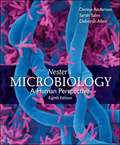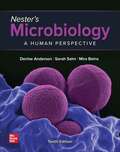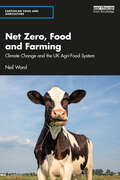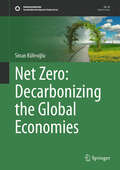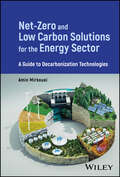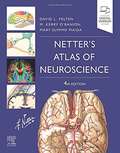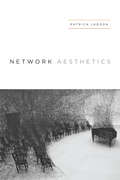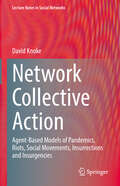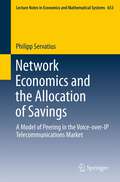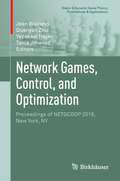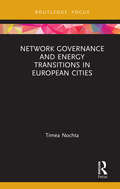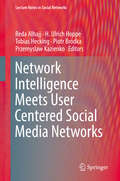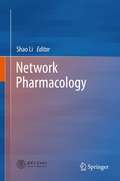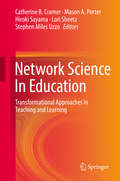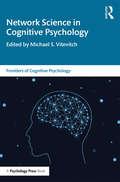- Table View
- List View
Nervous: Essays on Heritage and Healing
by Jen SorianoActivist Jen Soriano brings to light the lingering impacts of transgenerational trauma and uses science, history, and family stories to flow toward transformation in this powerful collection that brings together the lyric storytelling, cultural exploration, and thoughtful analysis of The Argonauts, The Woman Warrior, What My Bones Know, and Minor Feelings.The power of quiet can haunt us over generations, crystallizing in pain that Jen Soriano views as a form of embodied history. In this searing memoir in essays, Soriano, the daughter of a neurosurgeon, journeys to understand the origins of her chronic pain and mental health struggles. By the end, she finds both the source and the delta of what bodies impacted by trauma might need to thrive. In fourteen essays connected by theme and experience, Soriano traverses centuries and continents, weaving together memory and history, sociology and personal stories, neuroscience and public health, into a vivid tapestry of what it takes to transform trauma not just body by body, but through the body politic and ecosystems at large.Beginning with a shocking timeline juxtaposing Soriano’s medical history with the history of hysteria and witch hunts, Nervous navigates the human body—centering neurodiverse, disabled, and genderqueer bodies of color—within larger systems that have harmed and silenced Filipinos for generations. Soriano’s wide-ranging essays contemplate the Spanish-American War that ushered in United States colonization in the Philippines; the healing power of an inherited legacy of music; a chosen family of activists from the Bay Area to the Philippines; and how the fluidity of our nervous systems can teach us how to shape a trauma-wise future.With Nervous, Soriano boldly invites us along on a watershed journey toward healing, understanding, and communion.
Nester's Microbiology: A Human Perspective
by Denise Anderson Sarah Salm Mira Beins Ann Auman and Jennifer WalkerPerfect for the non-major/allied health student (and also appropriate for mixed majors courses), this text provides a rock solid foundation in microbiology. It has a concise and readable style, covers the most current concepts, and gives students the knowledge and mastery necessary to understand advances of the future. By carefully and clearly explaining the fundamental concepts, using a body systems approach in the coverage of disease, and offering vivid and appealing instructional art, Microbiology: A Human Perspective draws students back to their book again and again!
Nester's Microbiology: A Human Perspective
by Denise G. Anderson Sarah Salm Deborah AllenPerfect for the non-major/allied health student (and also appropriate for mixed majors courses), this text provides a rock solid foundation in microbiology. By carefully and clearly explaining the fundamental concepts and offering vivid and appealing instructional art, Microbiology: A Human Perspective draws students back to their book again and again! The text has a concise and readable style, covers the most current concepts, and gives students the knowledge and mastery necessary to understand advances of the future. A body systems approach is used in the coverage of diseases.
Nester's Microbiology: A Human Perspective
by Eugene W. Nester Denise G. Anderson Sarah Salm Mira BeinsPerfect for the non-major/allied health student (and also appropriate for mixed majors courses), this text provides a rock solid foundation in microbiology. It has a concise and readable style, covers the most current concepts, and gives students the knowledge and mastery necessary to understand advances of the future. By carefully and clearly explaining the fundamental concepts, using a body systems approach in the coverage of disease, and offering vivid and appealing instructional art, Microbiology: A Human Perspective draws students back to their book again and again!
Nestor's Dock: Out There
by Tom LaBaffAs Phil is star-gazing with his friend one night, he decides that he no longer wants to live on Earth and he wants to live on a different planet in Space. Phil has to decide which new planet that he can move to but quickly finds out that many of his choices are not quite livable. Will Phil ever to able to explore what really is out there or will Earth be his home forever?
Net Zero Economy, Corporate Social Responsibility and Sustainable Value Creation: Exploring Strategies, Drivers, and Challenges (CSR, Sustainability, Ethics & Governance)
by Shahbaz Khan Anil Kumar Sunil Luthra Rubee Singh Hemakshi ChokshiThis edited volume brings together contributions from multiple experts in academia to explore the practical implications of the Net Zero Economy for corporate social responsibility and sustainable value creation in today's world. As the world approaches net-zero emissions by 2050, it is crucial for businesses to take corporate social responsibility seriously and make credible attempts to achieve sustainable value creation while reducing their greenhouse gas emissions. The book provides a comprehensive guide to navigating the complexities of corporate responsibility in the net-zero economy, drawing on the expertise of scholars in sustainable supply chain, environmental sciences, management, sustainable business management, and social sciences. With contributions from multiple experts, it examines the challenges that businesses face in reducing their climate impact and highlights the green growth opportunities that they can take advantage of in the net-zero transition. This edited volume is an essential read for students, research scholars, and industrial professionals working in sustainable development, eco-friendly business management, and corporate social responsibility.
Net Zero Energy Building: Predicted and Unintended Consequences
by Ming HuWhat do we mean by net zero energy? Zero operating energy? Zero energy costs? Zero emissions? There is no one answer: approaches to net zero building vary widely across the globe and are influenced by different environmental and cultural contexts. Net Zero Energy Building: Predicted and Unintended Consequences presents a comprehensive overview of variations in 'net zero' building practices. Drawing on examples from countries such as the United States, United Kingdom, Germany, Japan, Hong Kong, and China, Ming Hu examines diverse approaches to net zero and reveals their intended and unintended consequences. Existing approaches often focus on operating energy: how to make buildings more efficient by reducing the energy consumed by climate control, lighting, and appliances. Hu goes beyond this by analyzing overall energy consumption and environmental impact across the entire life cycle of a building—ranging from the manufacture of building materials to transportation, renovation, and demolition. Is net zero building still achievable once we look at these factors? With clear implications for future practice, this is key reading for professionals in building design, architecture, and construction, as well as students on sustainable and green architecture courses.
Net Zero, Food and Farming: Climate Change and the UK Agri-Food System (Earthscan Food and Agriculture)
by Neil WardThis book examines the implications of the net zero transition for food and farming in the UK and how these can be managed to avoid catastrophic climate change in the crucial decades ahead. For the UK to meet its international obligations for reducing greenhouse gas emissions, nothing short of a revolution is required in our use of land, our farming practices and our diet. Taking a historical approach, the book examines the evolution of agriculture and the food system in the UK over the last century and discusses the implications of tackling climate change for food, farming and land use, setting the UK situation in an international context. The chapters analyse the key challenges for this transition, including dietary change and food waste, afforestation and energy crops, and low-emission farming practices. This historical perspective helps develop an understanding of how our food, farming and land use system has evolved to be the way that it is, and draws lessons for how the agri-food system could evolve further to support the transition to net zero and avoid catastrophic climate change. Written in a clear and accessible style, this book will be essential reading to students and scholars of food, agriculture and the environment, as well as policymakers and professionals involved climate change policy and the agriculture and food industry.
Net Zero: Decarbonizing the Global Economies (Sustainable Development Goals Series)
by Sinan KüfeoğluThis monograph is designed to provide a comprehensive and accessible reference to Net Zero efforts globally. Firstly, the book explains the basics of Net Zero, Greenhouse Gas Emissions (GHG), and the global climate change struggle. A chapter on Environmental, Social, and Governance (ESG), as standardisation and screening of sustainability follows. Next comes a chapter on carbon pricing and carbon tax. After these background chapters, the book continues with eight chapters that cover Net Zero across a variety of economic sectors: energy supply, business sector, transport, residential, industrial processes, waste management, public (and government), and agriculture, forestry and land use. These economic sectors are adopted from the Intergovernmental Panel on Climate Change (IPCC) and UK National Statistics. Each chapter includes basic background information, technical or scientific, and a policy section. The sector-based chapters also include sectoral emissions analysis, review, and then a horizon scanning for innovative companies and their business models. This will enable non-experts from the business sector to read and understand the dynamics and trends in other sectors. Similarly, students and fresh graduates will easily follow the chapter (or the industry) that interests them and comprehend the basics and contemporary business trends. By joining research work with the business models of 400 noteworthy and innovative companies, this book constructs a vital bridge between academia, practical reality, policy, and business implementation, with a keen focus on environmental value.
Net-Zero and Low Carbon Solutions for the Energy Sector: A Guide to Decarbonization Technologies
by Amin MirkoueiNet-Zero and Low Carbon Solutions for the Energy Sector Guide to choosing and investing in decarbonization technologies for the energy sector Net-Zero and Low Carbon Solutions for the Energy Sector proposes mature (high technology readiness level) net-zero and low carbon pathways and technologies in the energy sector, discussing net-/near-zero solutions for producing and storing power, heat, biofuel, and hydrogen, and highlighting various pathways and processes to achieve net-zero targets and address climate concerns. Each chapter provides a relevant case study to aid in the practical application of concepts, covering decarbonization solutions that have high potential to be used in the near future, such as solar-hybrid systems for net-zero power generation, CCUS-hybrid systems for low carbon power generation, pumped hydropower for power storage, commercial concentrating solar power plants for heat generation, gasification with CCUS for biofuel production, hybrid thermochemical process for hydrogen production, and more. Written from the perspective of firsthand research experience in the field, this book includes information on: Net-zero power generation via solar, wind, hydropower, geothermal, hydrogen, and marine processesNear-zero power generation via nuclear, coal, natural gas, biomass, and ammonia processesMechanical and battery-based power storage and heat storage via physical and thermochemical processesNear-zero heat generation processes and biofuels production, including biogas, biomethane, bioethanol, and biodieselHydrogen production via electrolysis and thermochemical processes with CCUS and low-emission technologies for hydrogen storage Net-Zero and Low Carbon Solutions for the Energy Sector is a valuable resource for business professionals, academics, and policy makers who are active in contributing to net-zero emissions targets for keeping the atmospheric CO2 levels in an acceptable range.
Netflix®: How Reed Hastings Changed the Way We Watch Movies & TV
by Aurelia JacksonToday, when you want to watch a movie or television show, there's a good chance you may choose to watch it using Netflix, one of the most popular video services on the Internet. With thousands of movies and TV shows, Netflix has changed the way we watch our favorite entertainment. You may use Netflix every day--but do you know the story of the man behind the company's success? Netflix was once only an idea in the mind of Reed Hastings, a businessman who has done amazing things since starting the online movie and TV company. Discover how Reed was able to make Netflix a success around the world--and find out what he has planned next to keep the company on top.
Netter's Atlas of Neuroscience (Netter Basic Science)
by David L. Felten Michael K. O'Banion Mary Summo MaidaIdeal for any student of neuroanatomy, neuroscience, or other medical or science disciplines involving the nervous system, Netter's Atlas of Neuroscience, 4th Edition, is a highly visual, clinically oriented exploration of structure and function―from neurons to motor and sensory systems to global neural function and dysfunction. This award-winning text approaches this complex topic from three perspectives: Neuroscience Overview, Regional Neuroscience, and Systemic Neuroscience. Illustrations by Frank H. Netter, MD, and others following in his tradition are framed by concise, expert text and accompanied by neuroimaging, photomicrographs, and summary diagrams.
Network Aesthetics
by Patrick JagodaThe term "network" is now applied to everything from the Internet to terrorist-cell systems. But the word's ubiquity has also made it a cliché, a concept at once recognizable yet hard to explain. Network Aesthetics, in exploring how popular culture mediates our experience with interconnected life, reveals the network's role as a way for people to construct and manage their world--and their view of themselves. Each chapter considers how popular media and artistic forms make sense of decentralized network metaphors and infrastructures. Patrick Jagoda first examines narratives from the 1990s and 2000s, including the novel Underworld, the film Syriana, and the television series The Wire, all of which play with network forms to promote reflection on domestic crisis and imperial decline in contemporary America. Jagoda then looks at digital media that are interactive, nonlinear, and dependent on connected audiences to show how recent approaches, such as those in the videogame Journey, open up space for participatory and improvisational thought. Contributing to fields as diverse as literary criticism, digital studies, media theory, and American studies, Network Aesthetics brilliantly demonstrates that, in today's world, networks are something that can not only be known, but also felt, inhabited, and, crucially, transformed.
Network Biology
by Andrew Emili Gerard CagneyWhile extremely large datasets describing gene sequences, mRNA transcripts, protein abundance, and metabolite concentrations are increasingly commonplace, these represent only starting 'parts lists' that are usually insufficient to unlock mechanistic insights on their own right. Fortunately, as Network Biology: Methods and Applications examines, concepts emerging from the study of biological entities such as networks (e.g. functional interactions linking genes, proteins, metabolites, etc.) suggest that order rather than chaos prevails, with such principles as modular and hierarchical organization, reactive information-driven causal-response behaviours, systems robustness, co-evolution, and self-organization guiding the way. This volume presents detailed, practical descriptions of the experimental and computational approaches currently prevalent in network biology as written by practiced experts in the field. Written in the highly successful Methods in Molecular BiologyTM series format, relevant chapters contain introductions to their respective topics, lists of the necessary materials, step-by-step, readily reproducible protocols, and tips on troubleshooting and avoiding known pitfalls. Comprehensive and accessible, Network Biology: Methods and Applications provides an ensemble of procedures that will be of great value to a broad assortment of readers, ranging from graduate students to seasoned professionals looking to polish their skill sets.
Network Collective Action: Agent-Based Models of Pandemics, Riots, Social Movements, Insurrections and Insurgencies (Lecture Notes in Social Networks)
by David KnokeCollective action asks a fundamental question in social science: How do sets of actorschoose courses of action and work together to achieve desired outcomes, often inopposition to other coalitions? Psychological and economic rationality explanations areincomplete in emphasizing the mental decision processes of individuals. Collectiveaction must be understood at the level analysis of interpersonal and interorganizationalrelations. Social network theories and methods provide optimal frameworks forexplaining collective action in a variety of settings. This book reviews theories andempirical research on collective action in several substantive areas, demonstrates howagent-based models can analyze collective action networks (pandemics, riots, socialmovements, insurrections, insurgencies), and concludes with speculations about futureresearch directions.
Network Economics and the Allocation of Savings
by Philipp ServatiusThis book provides a game theoretic model of interaction among VoIP telecommunications providers regarding their willingness to enter peering agreements with one another. The author shows that the incentive to peer is generally based on savings from otherwise payable long distance fees. At the same time, termination fees can have a countering and dominant effect, resulting in an environment in which VoIP firms decide against peering. Various scenarios of peering and rules for allocation of the savings are considered. The first part covers the relevant aspects of game theory and network theory, trying to give an overview of the concepts required in the subsequent application. The second part of the book introduces first a model of how the savings from peering can be calculated and then turns to the actual formation of peering relationships between VoIP firms. The conditions under which firms are willing to peer are then described, considering the possible influence of a regulatory body.
Network Games, Control, and Optimization
by Eilon Solan Samson Lasaulce Tania JimenezThis contributed volume offers a collection of papers presented at the 2016 Network Games, Control, and Optimization conference (NETGCOOP), held at the University of Avignon in France, November 23-25, 2016. These papers highlight the increasing importance of network control and optimization in many networking application domains, such as mobile and fixed access networks, computer networks, social networks, transportation networks, and, more recently, electricity grids and biological networks. Covering a wide variety of both theoretical and applied topics in the areas listed above, the authors explore several conceptual and algorithmic tools that are needed for efficient and robust control operation, performance optimization, and better understanding the relationships between entities that may be acting cooperatively or selfishly in uncertain and possibly adversarial environments. As such, this volume will be of interest to applied mathematicians, computer scientists, engineers, and researchers in other related fields.
Network Games, Control, and Optimization: Proceedings Of Netgcoop 2016, Avignon, France (Static & Dynamic Game Theory: Foundations & Applications)
by Quanyan Zhu Tania Jimenez Jean Walrand Yezekael HayelThis contributed volume offers a collection of papers presented at the 2016 Network Games, Control, and Optimization conference (NETGCOOP), held at the University of Avignon in France, November 23-25, 2016. These papers highlight the increasing importance of network control and optimization in many networking application domains, such as mobile and fixed access networks, computer networks, social networks, transportation networks, and, more recently, electricity grids and biological networks. Covering a wide variety of both theoretical and applied topics in the areas listed above, the authors explore several conceptual and algorithmic tools that are needed for efficient and robust control operation, performance optimization, and better understanding the relationships between entities that may be acting cooperatively or selfishly in uncertain and possibly adversarial environments. As such, this volume will be of interest to applied mathematicians, computer scientists, engineers, and researchers in other related fields.
Network Governance and Energy Transitions in European Cities (Routledge Focus on Energy Studies)
by Timea NochtaThis book investigates and evaluates the opportunities and limitations of network governance in building local capacity for energy infrastructure governance. Presenting a comparative analysis of three city cases from across Europe- Birmingham, Frankfurt and Budapest- this book demonstrates how local factors shape the prospect of network governance to support low-carbon energy transitions. It maps out existing governance networks, highlighting the actors involved and their interactions with one another, and also discusses the role and embeddedness of networks in the urban governance of low-carbon energy. Drawing on case study evidence, Nochta develops a comparative analysis which discusses the intricate connections between network characteristics, context and impact. It highlights that organisational fragmentation; the complexity of the low-carbon energy problem and historical developments all influence network characteristics in terms of degree of integration and vertical (hierarchical) power relationships among network actors. Overall, the book concludes that understanding such links between context and networks is crucial when designing and implementing new governance models aimed at facilitating and governing low-carbon urban development. Low-Carbon Energy Transitions in European Cities will be of great interest to scholars of energy policy, urban governance and sustainability transitions.
Network Intelligence Meets User Centered Social Media Networks (Lecture Notes in Social Networks)
by Reda Alhajj H. Ulrich Hoppe Tobias Hecking Piotr Bródka Przemyslaw KazienkoThis edited volume presents advances in modeling and computational analysis techniques related to networks and online communities. It contains the best papers of notable scientists from the 4th European Network Intelligence Conference (ENIC 2017) that have been peer reviewed and expanded into the present format. The aim of this text is to share knowledge and experience as well as to present recent advances in the field. The book is a nice mix of basic research topics such as data-based centrality measures along with intriguing applied topics, for example, interaction decay patterns in online social communities. This book will appeal to students, professors, and researchers working in the fields of data science, computational social science, and social network analysis.
Network Pharmacology
by Shao LiThis book introduces “network pharmacology” as an emerging frontier subject of systematic drug research in the era of artificial intelligence and big data. Network Pharmacology is an original subject of fusion system biology, bioinformatics, network science and other related disciplines. It emphasizes on starting from the overall perspective of the system level and biological networks, the analysis of the laws of molecular association between drugs and their treatment objects, reveals the systematic pharmacological mechanisms of drugs, and guides the research and development of new drugs and clinical diagnosis and treatment. After it was proposed, network pharmacology has been paid attention by researchers, and it has been rapidly developed and widely used. In order to systematically reveal the biological basis of diagnosis and treatment in traditional Chinese medicine and modern medicine, we proposed a new concept of "network target" for the first time, which has become the core theory of "network pharmacology". The core principle of a network target is to construct a biological network that can be used to decipher complex diseases. The network is then used as the therapeutic target, to which multicomponent remedies are applied. This book mainly includes four parts: 1) The concept and theory of network pharmacology; 2) Common analysis methods, databases and software in network pharmacological research; 3) Typical cases of traditional Chinese medicine modernization and modern drug research based on network pharmacology; 4) Network pharmacology practice process based on drugs and diseases.
Network Reliability in Practice
by Michael Bell David M. Levinson Henry X. LiuThis book contains selected peer-reviewed papers that were presented at the Fourth International Symposium on Transportation Network Reliability (INSTR) Conference held at the University of Minnesota July 22-23, 2010. International scholars, from a variety of disciplines--engineering, economics, geography, planning and transportation--offer varying perspectives on modeling and analysis of the reliability of transportation networks in order to illustrate both vulnerability to day-to-day and unpredictability variability and risk in travel, and demonstrates strategies for addressing those issues. The scope of the chapters includes all aspects of analysis and design to improve network reliability, specifically user perception of unreliability of public transport, public policy and reliability of travel times, the valuation and economics of reliability, network reliability modeling and estimation, travel behavior and vehicle routing under uncertainty, and risk evaluation and management for transportation networks. The book combines new methodologies and state of the art practice to model and address questions of network unreliability, making it of interest to both academics in transportation and engineering as well as policy-makers and practitioners.
Network Science
by Desmond J. Higham Gian-Luca Oppo Ernesto Estrada Maria FoxNetwork Science is the emerging field concerned with the study of large, realistic networks. This interdisciplinary endeavor, focusing on the patterns of interactions that arise between individual components of natural and engineered systems, has been applied to data sets from activities as diverse as high-throughput biological experiments, online trading information, smart-meter utility supplies, and pervasive telecommunications and surveillance technologies. This unique text/reference provides a fascinating insight into the state of the art in network science, highlighting the commonality across very different areas of application and the ways in which each area can be advanced by injecting ideas and techniques from another. The book includes contributions from an international selection of experts, providing viewpoints from a broad range of disciplines. It emphasizes networks that arise in nature--such as food webs, protein interactions, gene expression, and neural connections--and in technology--such as finance, airline transport, urban development and global trade. Topics and Features: begins with a clear overview chapter to introduce this interdisciplinary field; discusses the classic network science of fixed connectivity structures, including empirical studies, mathematical models and computational algorithms; examines time-dependent processes that take place over networks, covering topics such as synchronisation, and message passing algorithms; investigates time-evolving networks, such as the World Wide Web and shifts in topological properties (connectivity, spectrum, percolation); explores applications of complex networks in the physical and engineering sciences, looking ahead to new developments in the field. Researchers and professionals from disciplines as varied as computer science, mathematics, engineering, physics, chemistry, biology, ecology, neuroscience, epidemiology, and the social sciences will all benefit from this topical and broad overview of current activities and grand challenges in the unfolding field of network science.
Network Science In Education: Transformational Approaches in Teaching and Learning
by Mason A. Porter Hiroki Sayama Catherine B. Cramer Lori Sheetz Stephen Miles UzzoAround the globe, there is an increasingly urgent need to provide opportunities for learners to embrace complexity; to develop the many skills and habits of mind that are relevant to today's complex and interconnected world; and to make learning more connected to our rapidly changing workplace and society. This presents an opportunity to (1) leverage new paradigms for understanding the structure and function of teaching and learning communities, and (2) to promote new approaches to developing methods, curricular materials, and resources. Network science - the study of connectivity - can play an important role in these activities, both as an important subject in teaching and learning and as a way to develop interconnected curricula. Since 2010, an international community of network science researchers and educators has come together to raise the global level of network literacy by applying ideas from network science to teaching and learning. Network Science in Education - which refers to both this community and to its activities - has evolved in response to the escalating activity in the field of network science and the need for people to be able to access the field through education channels. Network Science In Education: Transformational Approaches in Teaching and Learning appeals to both instructors and professionals, while offering case studies from a wide variety of activities that have been developed around the globe: the creation of entirely new courses and degree programs; tools for K-20 learners, teachers, and the general public; and in-depth analysis of selected programs. As network-based pedagogy and the community of practice continues to grow, we hope that the book's readers will join this vibrant network education community to build on these nascent ideas and help deepen the understanding of networks for all learners.
Network Science in Cognitive Psychology (Frontiers of Cognitive Psychology)
by Michael S. VitevitchThis volume provides an integrative review of the emerging and increasing use of network science techniques in cognitive psychology, first developed in mathematics, computer science, sociology, and physics. The first resource on network science for cognitive psychologists in a growing international market, Vitevitch and a team of expert contributors provide a comprehensive and accessible overview of this cutting-edge topic. This innovative guide draws on the three traditional pillars of cognitive psychological research–experimental, computational, and neuroscientific–and incorporates the latest findings from neuroimaging. The network perspective is applied to the fundamental domains of cognitive psychology including memory, language, problem-solving, and learning, as well as creativity and human intelligence, highlighting the insights to be gained through applying network science to a wide range of approaches and topics in cognitive psychology Network Science in Cognitive Psychology will be essential reading for all upper-level cognitive psychology students, psychological researchers interested in using network science in their work, and network scientists interested in investigating questions related to cognition. It will also be useful for early career researchers and students in methodology and related courses.


